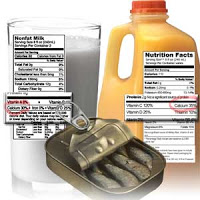As educated and intelligent consumers, we try to arm ourselves with as much information as we can so we can make good choices when it comes to food.
Unfortunately, it’s not always easy to get hold of the truth when you’re trying to determine what’s best for your diet. Here are some facts that might surprise you.
1. Americans eat 5 times as much high fructose corn syrup as sweet corn
 Every year, American farmers harvest almost 90 million acres of corn. Only about 1 percent of this is sold as sweet corn – canned or frozen corn, or corn on the cob.
Every year, American farmers harvest almost 90 million acres of corn. Only about 1 percent of this is sold as sweet corn – canned or frozen corn, or corn on the cob.
Quiz: Is Your Body TOXIC? Take the Test...
(get your free personalized report)
About 5 percent, on the other hand, is used to make high fructose corn syrup (HFCS), a sweetener that’s pervasive in packaged foods. HFCS is not only found in sodas and desserts; it’s also added to bread, cold cuts, soups, sauces, dressings, and canned and frozen foods.
Between 1970 and 1990, consumption of HFCS in America increased by more than 1000%. Researchers think the increased consumption of HFCS is a major contributor to the current obesity epidemic.
2. Your beef probably comes from cows that don’t eat grass
What happens to the rest of the corn? Some of it is used to create ethanol, but about half is used as animal feed. Industrial farmers who want to make a profit don’t feed their cows grass; they feed them cheap grain – corn and soybeans – instead.
Research shows that grass-fed beef is less fattening and does not have as much cholesterol as grain-fed beef. However, grass-fed beef is expensive and hard to find.
3. “All natural” doesn’t mean “nothing added”
According to the FDA, a food can be labeled all natural as long as it “does not contain added color, artificial flavors, or synthetic substances.” This means that foods loaded with HFCS can be labeled all natural.
Quiz: Is Your Body TOXIC? Take the Test...
(personalized report)
4. There are no rules about serving sizes
Manufacturers can make serving sizes as large or as small as they want. A smaller serving size on a label can make it seem as though the food has less calories. You might be delighted to find chocolate chip cookies that are just 10 calories per serving – until you realize that the serving size is a fifth of a cookie.
Manufacturers even manipulate serving sizes to make it seem like they are reducing the number of calories in their foods. Drop the serving size on a bag of potato chips from 12 chips to 8, and suddenly a serving is one third less fattening.
Remember to consider serving sizes when determining how many calories, and how much fat, sugar and salt a food contains. Consider taking a calculator with you to the supermarket.
5. Fat-free and sugar-free foods can contain fat and sugar
The FDA says food manufacturers can label foods with less than 0.5 grams of fat or sugar per 100 grams as fat or sugar-free. If you consume such foods often, those small amounts of fat and sugar can add up.
6. Fortified foods aren’t always healthier
 You might think that a food with lots of added vitamins or minerals is your healthiest choice. That’s not always so. The FDA says that if a food loses nutrients during storage and processing, manufacturers can put these nutrients back. Manufacturers can also add nutrients to a food that many people would normally eat, instead of a food that is naturally more nutritious.
You might think that a food with lots of added vitamins or minerals is your healthiest choice. That’s not always so. The FDA says that if a food loses nutrients during storage and processing, manufacturers can put these nutrients back. Manufacturers can also add nutrients to a food that many people would normally eat, instead of a food that is naturally more nutritious.
So put that box of fortified breakfast cereal, made with processed ingredients, back on the shelf and make yourself some oatmeal, with fresh, whole oats, instead.
7. Fruits and vegetables are less nutritious than they used to be
So you’ve decided to avoid packaged foods altogether and only eat natural, fresh foods.
That orange you’re peeling – it’s not as healthy as it would have been 50 years ago.
Modern agricultural methods – which focus on increasing crop yield, not on improving nutritional value – have caused the nutrient content of fruits and vegetables to decrease significantly in the last 50 years.
You’d have to eat more fruits and vegetables than your grandparents did to get the same level of nutrition.
What can you do?
You have to eat, and you don’t always have time to cook from scratch or to search for organic foods. The food industry seems to care more about profit than keeping people healthy. Even fresh vegetables aren’t as good for you as they used to be.
How can you stay healthy?
Use this information to make wise choices. Avoid high fructose corn syrup in all packaged foods; not just cookies and cakes. Be sure to check serving sizes. Don’t be fooled by “sugar-free” and “fat-free” labels.
Above all, don’t depend on diet alone to keep you healthy. Get plenty of exercise. Spend some time outdoors. Laugh.
No matter what the food industry does, you can still take steps to get healthier every day.
Additional Sources:
